#brittle stars
Text
Wet Beast Wednesday: brittle stars
Some animals end up living in the shadows of others. Everyone knows about starfish, the famous branching echinoderms, and a lot of people know about brittle stars, but not as many people know that brittle stars aren't starfish, they're their own thing. But because they look similar, brittle stars are frequently mistaken for a type of starfish, rather than being recognized as their own animal. I aim to help these stars shine and be recognized as their own animal.

(Image ID: a green brittle star on a rock. It consists of a small, round central body with five long, slender arms arms emerging from it at equal distances from each other. Thea rams are lines on either side with small bristles. End ID)
Brittle stars are members of the class Ophiuroidea, which is closely related to Asteroidea, the true starfish. The name comes from the Greek "ophis", meaning "serpent", a reference to their long, skinny arms. Ophiuroidea is divided into two orders, Ophiurida (true brittle stars) and Euryalida (basket stars). As with all echinoderms, brittle stars are radially symmetrical, consisting of multiple body segments that radiate around a point, akin to the slices of a pizza. The majority of brittle star species have five segments, though a few have six or more. Similarly to starfish, brittle stars have their arms radiating out from a central disc. In brittle stars, all the organs are located in the disc and as long as the disc remains intact, the arms can be regrown. The mouth (which also functions as the anus) is located in the center of the disc and each body segment has a single jaw and tooth. Some starfish can regenerate into two animals if the disc is cut in half, but almost no brittle stars can survive being cut in half. That being said, some species can reproduce via fission, where the disc splits in half and each half regenerates into a fully-grown star. In brittle stars, the arms are narrower than the disc, making the disc much more visually distinct than in starfish, where it can be hard to tell where the disc ends and arm begins. The arms of a brittle star are slender and highly flexible. When in danger, a brittle star can sever one of its arms. This is usually done in response to predation, in hopes that a predator will opt to eat the arm while the star makes its escape. This is called autotomy and is the reason why the common name of these animals is brittle star. The arms are formed of multiple calcium carbonate plates called vertebral ossicles due to their resemblance to vertebrae. The ossicles are connected to each other by ball and socket joints, allowing for a great degree of flexibility. Most true brittle stars can flex their arms side to side, but not up and down, while basket stars can flex in all directions. In basket stars, the arms branch multiple times. Unlike starfish, brittle stars use their arms for locomotion. The arms move in a rowing motion to drag the star around. Some species can swim for short distances as well. By contrast, starfish (and urchins) move using tube feet. Tube feet are a common echinoderm trait and consist of small tubes with a sucker on one end that are inflated and moved with water pressure. Most echinoderms use their tube feet for movement and feeding. True brittle stars, by contrast, seem to use their tube feet primarily for sensory reception, though they are also used to help transport food to the mouth. Due to moving with their arms instead of tube feet, brittle stars are capable of much faster movement than starfish, though in short bursts. Like other echinoderms, brittle stars use a water vascular system, where water is drawn into the body and used to inflate and move the tube feet and as a substitute for blood. Brittle star reproduction is fairly standard for echinoderms. The males and females will release their gametes into the water column. Fertilized eggs develop into pluteus larvae, which swim using cilia. In the pluetus stage, echinoderms are bilaterally symmetrical. They become radially symmetrical during metamorphosis into the juvenile form.

(GIF ID. A pale white brittle star swimming by rapidly moving its legs. End ID).
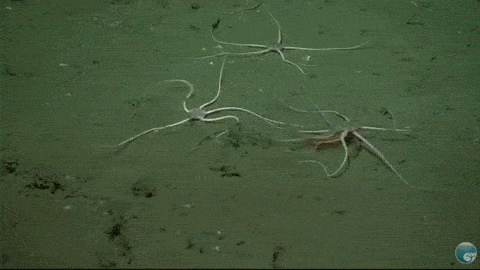
(GIF ID: two white brittle stars (with a third in the background) moving across sand by using their legs to push and drag themselves along. One appears to be carrying a red object in its mouth. End ID)

(Image ID: a basket star on a rock. The central disc in brown and has a pair of arms emerging from each segment. Each arm branches repeatedly and those branches have their own branches, resulting in a vaguely bush-like appearance. End ID)
Brittle stars are eyeless, but can detect light. Most animals, and a lot of non-animals, have some ability to detect the presence or absence of light. True vision, the ability to form images, requires more complex systems than the might-sensing cells most animals have. More specifically, it requires an eye. Or at least that's what we thought until scientists found evidence that the brittle star Ophiomastix wendtii may be able to form imaged without an eye by using its whole body as one big eye (a sea urchin, Diadema africanum) also seems to have this ability). Brittle stars are covered with light-sensing structures called opsins that can detect the presence or absence of light, but vision-forming sight requires the ability to determine how much light is coming from what direction. O. wendtii uses chromatophores to alter its color and these packets of pigment-changing cells are arranged in such a way that they may provide that directionality. In tests, O. wendtii would travel to shelter when exposed to light with a greater than change likelihood while the closely-related O. pumila would move at random when exposed to light. O. pumila lacks the types of pigment that O. wendti has, which could prevent it from being able to form the directionality needed for vision-forming sight. This is reflected in the species' behavior. O. wendtii moved toward shelter when exposed while O. pumila prefers to bury itself. The possibility for vision to exist without eyes means that a lot of animals we previously thought of as blind may actually be able to see, though probably not as well as animals with eyes.
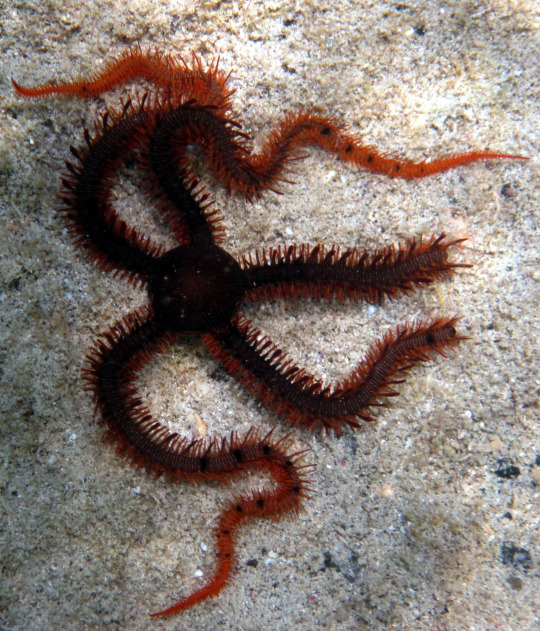
(Image ID: Ophiomastix wendtii, a red brittle star with larger bristles on its legs. Two legs are shorter and blunted, possibly having been damaged. End ID)
There are over 2,000 known species of brittle star that live all over the oceans, from shallow water to the deep sea. Most basket stars are seep-sea animals, though some shallow-water species are known. True brittle stars are mostly detritivores who crawl along sediment and eat bits of organic matter and tiny organisms. This behavior makes them seafloor engineers. Their feeding behavior stirs up the sediment, releasing nutrients and affecting the behavior of other species that rely on the sediment. Because of this, brittle stars are often highly important parts of their ecosystems. Some species follow different lifestyles. Some will target and eat sponges or coral polyps while others are active predators of small animals, filter feeders, or even omnivores that eat plant matter. Brittle stars often live in or on corals or sponges, which provide a source of protection. The relationship between star and coral or sponge may be symbiotic in some species, with the star eating parasites and pests that endanger its host. Basket stars are filter feeders that use their many branching arms to catch plankton. They need to live in places with a current as as such are often foudn on seamounts, where the underwater mountain directs the flow of water into currents. The star anchors itself to a rock, coral, or other surface and extends its arms into the current to make a net. The arms are lined with tiny hooks that catch plankton carried by the flowing water. Once caught, tube feet cover the plankton with mucus and transport it slowly to the mouth. The star will sometimes bring its arms to its mouth to speed up the process. When threatened, basket stars will bring in their legs and form a ball to protect the disc. Basket star arms are less muscular than those of true brittle stars and therefore they are not as fast. Basket stars generally get bigger than true brittle stars, with the largest species, Gorgonocephalus eucnemis, having a disc up to 14 cm (5.5 in) in diameter and an arm length of up to 70 cm (27.5 in).

(Image ID: a pale red brittle star with no bristles on its arms. It is climbing sea fan (type of coral with appearance similar to a fern), with its arms wrapped around the coral for stability. End ID)
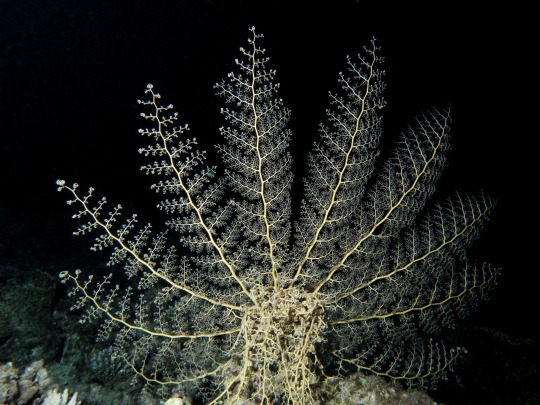
(Image ID: a basket star in feeding posture. It is on a rock with some of its arms used to support it. The rest of the arms are extended into the water column, with every branch fully extended. It looks kind of like pale white ferns. End ID).
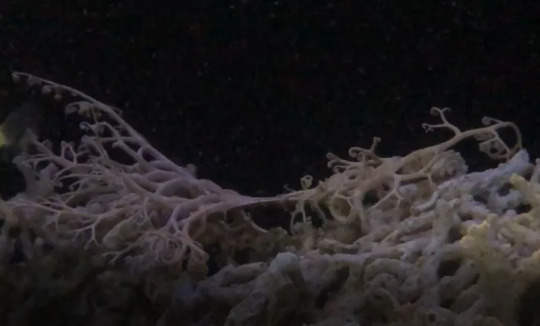
This basket star living in the St. Lucie County Aquarium in Ft. Pierce, Florida ripped itself in half shortly after being introduced to the exhibit. Esch half survived and regenerated into a full basket star. This is the only time this behavior has been seen in this species (Astrophytum muricatum). Of course, trying to rip yourself in half is a reasonable response to realizing you have to live in Florida.
(Image ID: a white basket star splitting into two halves, each with a portion of the arms. The only thing connecting the halves is a small strip of tissue. End ID)
#wet beast wednesday#brittle stars#basket stars#echinoderm#marine biology#marine life#animal facts#zoology#biology#ecology#pictures#image described
178 notes
·
View notes
Text
Headless animals called brittle stars have no brains at all and still manage to learn through experience, new research reveals.
Relatives of starfish, brittle stars spend most of their time hiding under rocks and crevices in the ocean or burrowing in the sand.
These shy marine creatures have no brain to speak of—just nerve cords running down each of their five wiggly arms, which join to form a nerve ring near their mouth.
“There’s no processing center,” says lead author Julia Notar, who did the research as part of her biology PhD in the lab of Sönke Johnsen, a professor at Duke University.
“Each of the nerve cords can act independently,” Notar says. “It’s like instead of a boss, there’s a committee.”
In the case of brittle stars, that seems to be enough to learn by association, Notar, Johnsen, and former Duke undergraduate Madeline Go report in the journal Behavioral Ecology and Sociobiology.
Continue Reading.
164 notes
·
View notes
Text
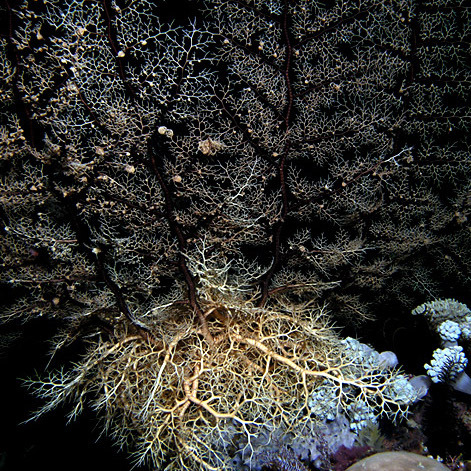
A basket star (Astroboa granulatus) unfurling at night to feed on plankton in East Timor
by Nick Hobgood
#basket stars#brittle stars#echinoderms#astroboa granulatus#astroboa#Gorgonocephalidae#Phrynophiurida#Ophiuroidea#echinodermata#wildlife: east timor#wildlife: asia
142 notes
·
View notes
Text
so I saw this video on my twitter tl of something called a Brittle Star and
this is literally just Venom irl
120 notes
·
View notes
Text
Taxonomy Tournament: Echinoderms
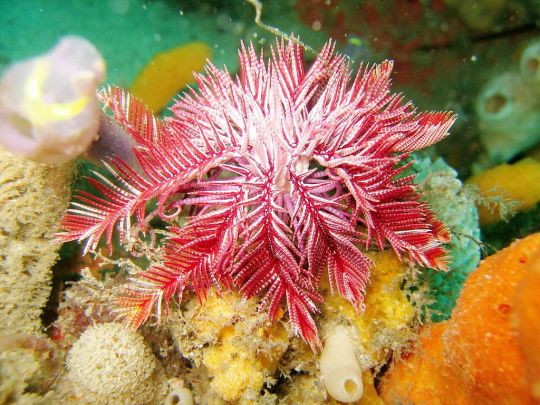
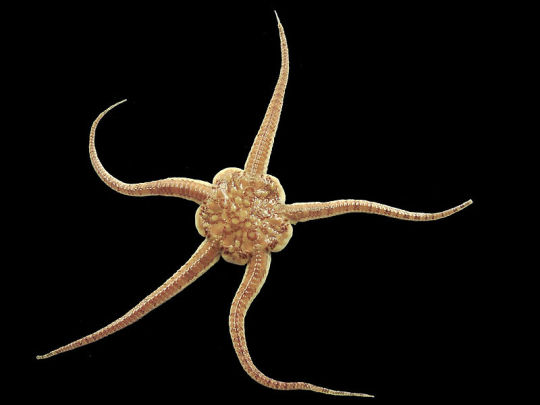
Articulata. This class is made up of sea lilies, which have a stalk an attach themselves to substrate in their adult forms, and feather stars, which are free-moving. They feed using arms with feathery pinnules.
Ophiuroidea. This class of starfish-like echoniderms, known as the brittle stars, has long slender whip-like arms
#animals#biology#polls#poll tournament#zoology#sea lilies#echinoderms#brittle stars#Articulata#Ophiuroidea#0x5v0xfa#Animal Tournament#Animal Tournament Round 1
47 notes
·
View notes
Text

Seashells, Crabs, and Sea Stars. Written by Christine Kump Tibbitts. Illustrated by Linda Garrow. 1998.
#marine life#echinoderms#sea cucumbers#sand dollars#brittle stars#sea stars#sea urchins#crustaceans#horseshoe crabs#hermit crabs#gastropods#snails#conches#cnidarians#anemones#Linda Garrow
1K notes
·
View notes
Text

Sea stars of British Columbia by David Hall
#sea stars#starfish#echinoderms#echinodermata#purple#orange#red#yellow#brittle stars#marine#ocean#sea#marine life#marine invertebrates#reef#coral reef#nature#animals
12 notes
·
View notes
Text

#my art#creature design#monster design#little guys#cute#illustration#lineless illustration#snowflake#ice#huevember#huevember 2023#blue#ice monster#radial symmetry#cyclops#brittle stars
25 notes
·
View notes
Text
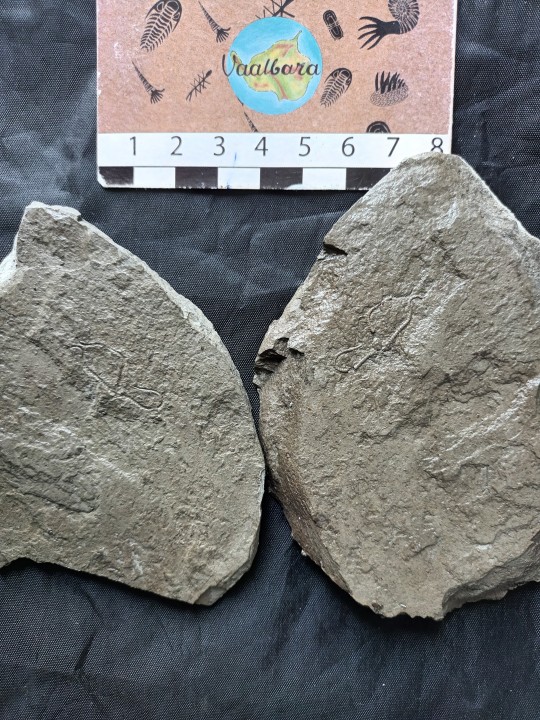
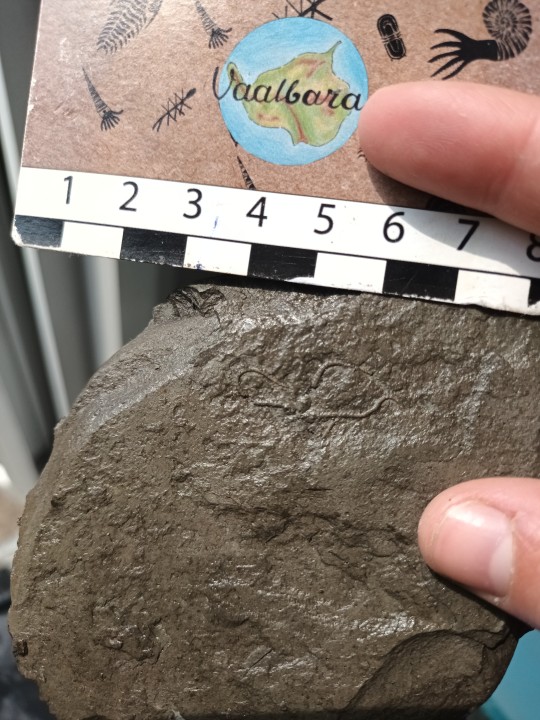

Brittle star from the Boulonnais.
These little guys are family of the starfish and are actually kind of rare to find in a fossilized state, because of their soft bodies
#fossil#fossils#boulonnais#fossil hunting#jurassic#palaeoblr#geology#paleontology#paleoblr#brittle stars#echinoderm
45 notes
·
View notes
Text
COMPLETE: Brittle Stars
Chapter 31/31: In the West the Glowing Light
This story is now complete at 119,431 words! In which Adar and Pengolodh have some decisions to make.
Óren of Lindon. Adar of Mordor. Side by side. Maybe not as separate as ink on a page might make them out to be. Sometimes the world blends. Sometimes things align. Sometimes they break apart and are forged back together again by an unseen hammer in the hand of fate. Sometimes one half of the truth bleeds into the other.
Sometimes, someone can be two things at once.
17 notes
·
View notes
Text
Found my final project from my college drawing class. We were supposed to do a piece in the style of an existing artist. I picked the artistic depictions of animals and other organisms by Ernst Haeckel and members of the phylum Echinodermata because I was doing my thesis on sea urchins

#art#charcoal#drawing#echinoderm#sea urchin#sea cucumber#crinoid#sand dollars#starfish#brittle stars
31 notes
·
View notes
Text

gorgonocephalus
#upload#fav#marine biology#marine biodiversity#marine life#marine animals#sea life#sea creature#exotic sea creatures#sea creatures#marine creatures#white#basket star#brittle star#brittle stars#animals#sea animals#ocean#ocean life#ocean animals#ocean creatures#Gorgonocephalus
64 notes
·
View notes
Photo

A basket star (Euryalida) in Newfoundland
by Derek Keats
#basket stars#brittle stars#echinoderms#euryalida#Phrynophiurida#Ophiuroidea#echinodermata#wildlife: newfoundland#wildlife: canada
49 notes
·
View notes
Photo

A moon jelly covered in brittle stars
Photo by Andrea Marshall
83 notes
·
View notes
Note
What's the greatest, bestest, sickest, coolest, aquatic organism?
Ooooohhhh I'm gonna regret answering this because I'll surely think of something later that I forgot... but here it goes! Some of the greatest, bestest, sickest, coolest, aquatic organisms:
Sharks (top tier)
Whales (evolved to go back in the water, which always amazes me when I think about it. look up the animation of a whale fall it's one of my favorite things ever)
Jellyfish (I got stung by one once and hated it but they are so so fascinating. did you know at least one species is immortal. do you know how big the lion's mane jelly is. look it up and ignore the photoshopped results.)
Crabs (I love them. look up a spider crab.)
Octopods and squid (that one squid with freakishly long tentacles. have you seen it. have you seen it)
Starfish (I love them. the Japanese word for starfish is hitode. the more appropriate name is sea star. they're predators.)
Brittle stars (like starfish but out of a nightmare)
Hagfish (like eels but gross)
Sharks are always the thing I think of first when I think of best ocean creatures but there is just no comparison between all of these. They are all so good and important <3
31 notes
·
View notes
Text
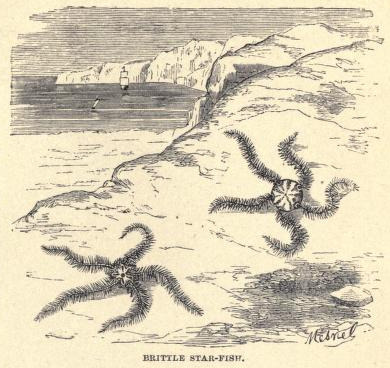
The Sea and its Wonders. Written by Mary and Elizabeth Kirby. 1871.
Internet Archive
76 notes
·
View notes